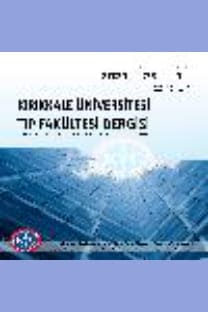Preoperatif Stent Uygulamasının Retrograd İntrarenal Cerrahi Sonuçları Üzerine Etkisi
IMPACT OF PREOPERATIVE STENT ON RETROGRADE INTRARENAL SURGERY OUTCOMES
___
- 1. Pietropaolo A, Proietti S, Geraghty R, Skolarikos A, Papatsoris A, Liatsikos E et al. Trends of 'urolithiasis: interventions, simulation, and laser technology' over the last 16 years (2000-2015) as published in the literature (PubMed): a systematic review from European section of Uro-technology (ESUT). World J Urol. 2017;35(11):1651-58.
- 2. Türk C, Knoll T, Petrik A, Sarica K, Skolarikos A, Straub M et al EAU guidelines on interventional treatment for urolithiasis. Eur Urol. 2016;69(3):475–82.
- 3. Rubenstein RA, Zhao LC, Loeb S, Shore DM, Nadler RB. Prestenting improves ureteroscopic stone-free rates. J Endourol. 2007;21(11):1277-80.
- 4. Traxer O and Thomas A. Prospective evaluation and classification of ureteral wall injuries resulting from insertion of a ureteral access sheath during retrograde intrarenal surgery. J Urol. 2013;189(2):580-4.
- 5. Benoit L, Spie R, Favoulet P, Cheynel N, Kretz B, Gouy S et al. Management of ureteral injuries. Ann Chir. 2005;130(8):451-7.
- 6. Pereira BM, Ogilvie MP, Gomez-Rodriguez JC, Ryan ML, Pena D, Marttos AC et al. A review of ureteral injuries after external trauma. Scand J Trauma Resusc Emerg Med. 2010;18:6. Doi: 10.1186/1757-7241-18-6.
- 7. Lee MH, Lee IJ, Kim TJ, Lee SC, Jeong CW, Hong SK et al. The effect of short-term preoperative ureteral stenting on the outcomes of retrograde intrarenal surgery for renal stones. World J Urol. 2019;37(7):1435-40.
- 8. Hubert KC, Palmer JS. Passive dilation by ureteral stenting before ureteroscopy: eliminating the need for active dilation. J Urol. 2005;174(3):1079-80.
- 9. Jones BJ, Ryan PC, Lyons O, Grainger R, McDermott TE, Butler MR. Use of the double pigtail stent in stone retrieval following unsuccessful ureteroscopy. Br J Urol. 1990;66(3):254-6.
- 10. Chu L, Sternberg KM, Averch TD. Preoperative stenting decreases operative time and reoperative rates of ureteroscopy. J Endourol. 2011;25(5):751-4.
- 11. Perlmutter AE, Talug C, Tarry WF, Zaslau S, Mohseni H, Kandzari SJ. Impact of stone location on success rates of endoscopic lithotripsy for nephrolithiasis. J Urol. 2007;71(2):214–17.
- 12. Zhang J, Xu C, He D, Lu Y, Hu H, Qin B et al. Flexible ureteroscopy for renal stone without preoperative ureteral stenting shows good prognosis. PeerJ. 2016;4:e2728.
- 13. Dindo D, Demartines N, Clavien PA. Classification of surgical complications: a new proposal with evaluation in a cohort of 6336 patients and results of a survey. Ann Surg. 2004;240(2):205-13.
- 14. Netsch C, Knipper S, Bach T, Herrmann TRW, Gross AJ. Impact of preoperative ureteral stenting on stone-free rates of ureteroscopy for nephroureterolithiasis: a matched-paired analysis of 286 patients. Urology. 2012;80(6):1214-9.
- 15. Ather MH, Paryani J, Memon A, Sulaiman MN. A 10-year experience of managing ureteric calculi: changing trends towards endourological intervention-is there a role for open surgery? BJU Int. 2001;88(3):173-7.
- 16. Auge BK, Sarvis JA, L’Esperance JO, Preminger GM. Practice patterns of ureteral stenting after routine ureteroscopic stone surgery: a survey of practice urologists. J Endourol. 2007;21(11):1287-91.
- 17. Shields JM, Bird VG, Graves R, Gomez-Marin O. Impact of preoperative ureteral stenting on outcome of ureteroscopic treatment for urinary lithiasis. J Urol. 2009;182(6):2768-74.
- 18. Lumma, PP, Schneider P, Strauss A, Plothe KD, Thelen P, Ringert RH et al. Impact of ureteral stenting prior to ureterorenoscopy on stone-free rates and complications. World J Urol. 2013;31(4):855-9.
- 19. Assimos D, Crisci A, Culkin D, Xue W, Roelofs A, Duvdevani M et al. Preoperative JJ stent placement in ureteric and renal stone treatment: results from the Clinical Research Office of Endourological Society (CROES) ureteroscopy (URS) Global Study. BJU Int. 2016;117(4):648-54.
- 20. Jessen JP, Breda A, Brehmer M, Liatsikos EN, Millan Rodriguez F, Osther PJ et al. International collaboration in endourology: Multicenter evaluation of prestenting for ureterorenoscopy. J Endourol. 2016;30(3):268-73.
- 21. Türk C, Neisius A, Petrik A, Seitz C, Skolarikos A, Thomas K. EAU guidelines on urolithiasis. 2018. https://uroweb.org/wp-content/uploads/EAU-Guidelines-on-Urolithiasis-2018-large-text.pdf.
- 22. Resorlu B, Unsal A, Gulec H, Oztuna D. A new scoring system for predicting stone-free rate after retrograde ıntrarenal surgery: The “resorlu-unsal stone score”. Urology. 2012;80(3):512-8.
- 23. Tonyalı S, Yılmaz M, Karaaslan M, Ceylan C, Işıkay L. Prediction of stone-free status after single-session retrograde intrarenal surgery for renal stones. Turk J Urol. 2018;44(6):473-7.
- ISSN: 2148-9645
- Yayın Aralığı: Yılda 3 Sayı
- Başlangıç: 1999
- Yayıncı: KIRIKKALE ÜNİVERSİTESİ KÜTÜPHANE VE DOKÜMANTASYON BAŞKANLIĞI
Melda MISIRLIOĞLU, Zahide MEŞHUR, Yağmur YILMAZ AKYIL
IMPACT OF PREOPERATIVE STENT ON RETROGRADE INTRARENAL SURGERY OUTCOMES
Ünal ÖZTEKİN, MEHMET CANİKLİOĞLU, Sercan SARI, Abdullah GÜREL, Volkan SELMİ, Levent IŞIKAY, Fatih ATAÇ
Akromegali: MRG Bulguları ile Birlikte Bir Olgu Sunumu
Şule ERDEM, Şuheda ERDEM, Kaan GÜNDÜZ
Hüseyin Avni EROĞLU, Başak BÜYÜK, YASEMEN ADALI, Aslan DEMİR
Fevziye İlknur KAYALI, Uğur TOPRAK, Rahşan HABİBOĞLU
Turgut KÜLTÜR, Gökce ŞİMŞEK, Hatice AGİR
İbrahim Halil YILDIRIM, Kağan KAMAŞAK, Zeynep YEĞİN
Kağan KAMAŞAK, Zeynep YEĞİN, İBRAHİM HALİL YILDIRIM
Preoperatif Stentin Retrograd İntrarenal Cerrahi Sonuçları Üzerine Etkisi
Ünal ÖZTEKİN, Mehmet CANİKLİOĞLU, Sercan SARI, Abdullah GÜREL, Volkan SELMİ, Levent IŞIKAY, Fatih ATAÇ
